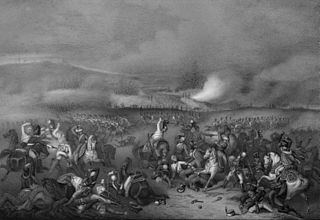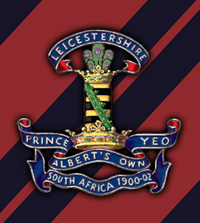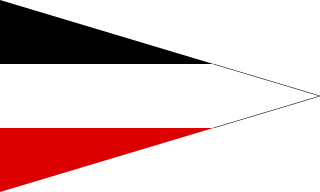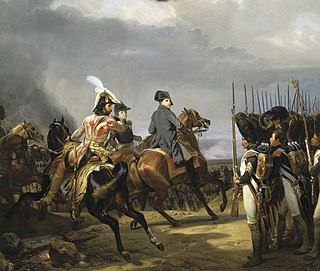
The Russian Imperial Guard, officially known as the Leib Guard were military units serving as personal guards of the Emperor of Russia. Peter the Great founded the first such units in 1683, to replace the politically motivated Streltsy. The Imperial Guard subsequently increased in size and diversity to become an elite corps of all branches within the Imperial Army rather than Household troops in direct attendance on the Tsar. Numerous links were however maintained with the Imperial family and the bulk of the regiments of the Imperial Guard were stationed in and around Saint Petersburg in peacetime. The Imperial Guard was disbanded in 1917 following the Russian Revolution.
This is the complete order of battle of the French and Third Coalition armies during the Battle of Austerlitz.

The Chevalier Guard Regiment was a Russian heavy cavalry guard regiment, created in 1800 by the reformation of the Chevalier Guard corps, itself created in 1764 by Catherine the Great. As other Russian heavy cavalry guard regiments, the Chevalier Guards were equipped as cuirassiers.
The Imperial Russian Army in June 1812 consisted of three main armies and other military formations. The Commander in Chief of the Army was Emperor Alexander I.

The Leicestershire Yeomanry (Prince Albert's Own) was a yeomanry regiment of the British Army, first raised in 1794 and again in 1803, which provided cavalry and mounted infantry in the Second Boer War and the First World War and provided two field artillery regiments of the Royal Artillery in the Second World War, before being amalgamated with the Derbyshire Yeomanry to form the Leicestershire and Derbyshire (Prince Albert's Own) Yeomanry in 1957. The regiment's lineage is currently perpetuated by E (Leicestershire and Derbyshire Yeomanry) Squadron of the Royal Yeomanry.

The Guards Cavalry Division (Garde-Kavallerie-Division) was a unit of the Prussian Army that was stationed in Berlin. The division was a part of the Guards Corps (Gardekorps).
The Household Cavalry Composite Regiment was a temporary, wartime-only, cavalry regiment of the British Army consisting of personnel drawn from the 1st Life Guards, 2nd Life Guards and Royal Horse Guards. It was active in 1882 for service in the Anglo-Egyptian War, in 1889–1900 during the Second Boer War, from August to November, 1914 during the opening months of World War I and in World War II.

The Imperial Russian Army or Russian Imperial Army was the armed land force of the Russian Empire, active from 1721 until the Russian Revolution of 1917. It was organized into a standing army and a state militia. The standing army consisted of regular troops and two forces that served on separate regulations: the Cossack troops and the Muslim troops.
During the territorial evolution of Russia, the 3rd Guard Infantry division in the Russian Empire consisted of four regiments: the Litovsky Guards Regiment, Kexholm Guards Regiment, St. Petersburg Guards Regiment, and the Volhynian Guard Regiment.
The 2nd Guards Cavalry Division was a Guards light cavalry division of the Imperial Russian Army.

The Jena-Auerstedt campaign order of battle is listed below. The order of battle includes units from the First French Empire and the Kingdom of Prussia that fought each other in the campaign that included the decisive Battle of Jena-Auerstedt on 14 October 1806. The order of battle may be useful to trace the battles of Schleiz and Saalfeld, which occurred before Jena-Auerstedt, as well as battles and capitulations that happened after 14 October, such as Erfurt, Halle, Prenzlau, Pasewalk, Stettin, Waren-Nossentin, and Lübeck.
The II Cavalry Corps of the Grande Armée was a French military unit that existed during the Napoleonic Wars. It was first formed in December 1806, but only enjoyed a brief existence under Marshal Jean-Baptiste Bessières. The II Cavalry Corps was reconstituted for the invasion of Russia in 1812 and commanded by General Louis-Pierre Montbrun who was killed in battle, as was his successor a few hours later. During the War of the Sixth Coalition, General Horace François Bastien Sébastiani de La Porta led the II Cavalry Corps in 1813, while General Antoine-Louis Decrest de Saint-Germain led the corps in 1814. During the Hundred Days, Emperor Napoleon Bonaparte raised the corps again and entrusted it to General Rémi Joseph Isidore Exelmans.

The 2nd Cavalry Division was a unit of the German Army in World War I. The division was formed on the mobilization of the German Army in August 1914. The division was disbanded in 1919 during the demobilization of the German Army after World War I.

The 6th Cavalry Division was a unit of the German Army that fought on Eastern and Western Fronts during World War I. The division was formed on the mobilization of the German Army in August 1914 and was disbanded in 1919 during the demobilization of the German Army after World War I.
The history of the German Cavalry in World War I is one of an arm in decline.
The IV Cavalry Corps of the Grande Armée was a French military unit that existed during the Napoleonic Wars. The corps was created in 1812 and rebuilt in 1813 and 1815. Emperor Napoleon I first organized the corps for the invasion of Russia. Under General Victor de Fay de La Tour-Maubourg, the corps fought at Borodino. During the War of the Sixth Coalition in 1813, General François Étienne de Kellermann commanded the all-Polish corps at Leipzig.
The 2nd Cavalry Division was a cavalry formation of the Russian Imperial Army.
The 1st Guards Corps was a corps-level command in the Russian Imperial Army that existed in the decades leading up to and during World War I. Stationed in St Petersburg, it included some of the oldest and best known regiments of the Emperor of All Russia's Imperial Guard.
The 20th Finnish Dragoon Regiment was a cavalry regiment of the Imperial Russian Army which saw service during the later half of the 19th Century and beginning of the 20th before disbanding following the October Revolution. Three regiments went by the name of 'Finnish Dragoon Regiment', of which the 20th was the last.

His Majesty's Life Guards Hussar Regiment was a Guards Hussar regiment of the Army of the Russian Empire.






